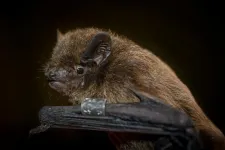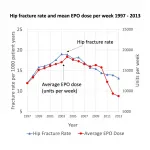Cryptic sense of orientation of bats localised: the sixth sense of mammals lies in the eye
2021-05-05
(Press-News.org) Mammals see with their eyes, hear with their ears and smell with their nose. But which sense or organ allows them to orient themselves on their migrations, which sometimes go far beyond their local foraging areas and therefore require an extended ability to navigate? Scientific experiments led by the Leibniz Institute for Zoo and Wildlife Research (Leibniz-IZW), published together with Prof. Richard A. Holland (Bangor University, UK) and Dr. Gunārs P?tersons (Latvia University of Life Sciences and Technologies) now show that the cornea of the eyes is the location of such an important sense in migrating bats. If the cornea is anaesthetised, the otherwise reliable sense of orientation is disturbed while light detection remains unimpaired. The experiment suggests the localisation of a magnetic sense in mammals. The paper is published in the scientific journal Communications Biology.
A research team led by Dr Oliver Lindecke and PD Dr Christian Voigt from Leibniz-IZW demonstrated for the first time that environmental signals that are important for navigating over long distances are picked up via the cornea of the eyes. They conducted experiments with Nathusius' bats (Pipistrellus nathusii) during the late summer migration period. In bats of one test group, the scientists locally anaesthetised the cornea with a drop of oxybuprocaine. This surface anaesthetic is widely used in ophthalmology, where it is used to temporarily desensitise the patients' cornea when eyes of humans or animals get overly irritated. Effects on orientation, however, had not been previously recorded. In another test group of bats, the research team anaesthetised the cornea of only one eye. The individuals in the control group were not anaesthetised, but instead received an isotonic saline solution as eye drops. All animals in this scientific experiment were captured within a migration corridor at the coastline of the Baltic Sea and released singly in the open field 11 kilometres inland from the capture site immediately after treatment. The scientists first used bat detectors to make sure that there were no other bats above the field at the time of release that the test animals could have followed. The person observing the direction of movement of released bats was unaware about how bats were treated experimentally. "The control group and the group with unilateral corneal anaesthesia oriented themselves clearly in the expected southerly directions, whereas the bats with bilateral anaesthetised corneas flew off in random directions," explains Dr Oliver Lindecke, first author of the paper. "This evident difference in behaviour suggests that corneal anaesthesia disrupted a sense of direction, yet orientation apparently still works well with one eye." As corneal treatment wears off after a short time, the bats were able to resume their journeys south after the experiment. "We observed here for the first time in an experiment how a migrating mammal was literally blown off course - a milestone in behavioural and sensory biology that allows us to study the biological navigation system in a more targeted way."
In order to rule out the possibility that the anaesthetisation of the cornea also affects the sense of sight and that the scientists would thus come to the wrong conclusions, they carried out a complementary test. Once again divided into experimental and control groups, they tested whether the response of bats to light changed after anaesthesia of the corneas on one or both sides. "We know from previous research that bats prefer an illuminated exit when leaving a simple Y-shaped labyrinth," explains PD Dr Christian Voigt, head of the Leibniz-IZW Department of Evolutionary Ecology. "In our experiment, the animals with one-sided or two-sided anaesthesia also showed this preference; we therefore can rule out that the ability to see light was altered after corneal treatment. The ability to see light would of course also influence long-distance navigation."
Many vertebrates such as bats, dolphins, whales, fish and turtles, for example, are able to safely navigate in darkness, whether it is under the open night sky, when it is cloudy at night or in caves and tunnels as well as in the depths of the oceans. For many decades, scientists have been searching for the sense or a sensory organ that enables animals to perform orientation and navigation tasks that seemed difficult to imagine for people. A magnetic sense, so far only demonstrated in a few mammals but poorly understood, is an obvious candidate. Experiments suggest that iron oxide particles within cells may act as "microscopic compass needles", as is the case in some species of bacteria.
Recent laboratory experiments on Ansell's mole-rat, relatives of the well-known naked mole rats that spend their lives in elaborate underground tunnel systems, suggest that the magnetic sense is located in the eye. Such a (magnetic) sense of orientation has not been checked in migratory mammals nor has it been possible to identify the specific organ or tissue which could provide the morphological basis for the required sensory receptors. The experiments of the team around Lindecke and Voigt now provide, for the first time, reliable data for the localisation of a sense of orientation in free-ranging, migratory mammals. Exactly what the sense in the cornea of the bats looks like, how it works and whether it is the long sought-after magnetic sense must be shown in future scientific investigations.
INFORMATION:
Publication
Lindecke O, Holland RA, P?tersons G, Voigt CC (2021): Corneal sensitivity is required for orientation in free-flying migratory bats. Communications Biology. DOI: 10.1038/s42003-021-02053-w
Contact
Carl von Ossietzky Universität Oldenburg
Carl-von-Ossietzky-Straße 9-11
26129 Oldenburg, Germany
_ Dr. rer. nat. Oliver Lindecke
AG Neurosensorik/Animal Navigation, IBU
Phone: +49 (0) 441 798 3806
Email: oliver.lindecke@uni-oldenburg.de
Leibniz Institute for Zoo and Wildlife Research (Leibniz-IZW)
in the Forschungsverbund Berlin e.V.
Alfred-Kowalke-Str. 17, 10315 Berlin
_ PD Dr Christian Voigt
Head of the Department of Evolutionary Ecology
Phone: +49 30 5168 511
Email: voigt@izw-berlin.de
_ Jan Zwilling
Science communication
Phone: +49 30 5168 121
Email: zwilling@izw-berlin.de
[Attachments] See images for this press release:

ELSE PRESS RELEASES FROM THIS DATE:
2021-05-05
A study involving researchers at Karolinska Institutet and Gothenburg University in Sweden has found that low levels of a protein called PDGFRb are associated with particularly good results of radiotherapy in women with early-stage breast cancer. The study, which is published in the journal Clinical Cancer Research, also suggests that the efficacy of radiotherapy can be improved with drugs that block this protein.
Some 900 women in Sweden are diagnosed with DCIS (ductalcarcinoma in situ), the earliest possible form of invasive breast cancer. Standard treatment is ...
2021-05-05
MINNEAPOLIS - Chronic kidney disease is when a person's kidneys progressively lose their ability to filter waste from the blood and eliminate fluids. Now a new study has found that people with reduced kidney function may have an increased risk of developing dementia. The study is published in the May 5, 2021, online issue of Neurology®, the medical journal of the American Academy of Neurology.
Chronic kidney disease affects approximately 15% of adults in the United States and it is more common as people age. However, since many people don't experience ...
2021-05-05
CLEVELAND, Ohio (May 5, 2021)--Vitamin D is a critical part of a healthy diet. Among other benefits, it has been shown to protect against bone disease and maintain soft tissue health. A new study suggests that it may also play a role in the degree of postoperative pain postmenopausal women experience after undergoing total knee replacement. Study results are published online today in Menopause, the journal of The North American Menopause Society (NAMS).
Vitamin D deficiency is a major issue globally. It is estimated that 60% of adults have insufficient levels of the bone-building vitamin. Estrogen deficiency in perimenopausal women has been associated with decreased levels of vitamin D. A sedentary lifestyle and lack of sun exposure have also been shown to contribute to vitamin D ...
2021-05-05
A new study published in the British Journal of Clinical Pharmacology ¬provides insights on how common hospitalized patients develop liver injury from taking different medications.
When investigators analyzed the records of 156,570 hospitalized patients, they found 499 cases of drug-induced liver injury (DILI), for an incidence of 0.32%. Anti-infective agents, cancer medications, and nonsteroidal anti-inflammatory drugs were the major categories of drugs causing DILI, and the highest incidence was due to voriconazole (an antifungal medication). Patients with high cholesterol, cardiovascular disease, ...
2021-05-05
A new study published in Arthritis Care & Research indicates that few individuals with the autoimmune disease lupus who were publicly insured through Medicaid received recommended vaccines in 2000-2010. Also, those who were unvaccinated needed more acute care for vaccine-preventable illnesses.
From 2000-2010, there were 1,290 patients who visited the emergency department or were hospitalized for vaccine-preventable illness, and 93% of these visits occurred in patients without billing codes for related vaccinations. Patients who were Black had a 22% higher risk of needing such care than those who were white.
"These episodes represent missed opportunities to deliver essential ...
2021-05-05
Untreated mental health disorders can be a serious problem for women and their children during pregnancy and after giving birth, during the postpartum period. A recent analysis funded by the Agency for Healthcare Research and Quality (AHRQ) and published in Psychiatric Research & Clinical Practice notes that few studies have examined the benefits of medications for mental health disorders in pregnant and postpartum women. And while many studies have reported on potential harms, the large majority could not separate the effect of medications from the effect of the underlying disorder. As a result, it ...
2021-05-05
Investigators found similarities in the bacterial composition of the mouth among patients with early rheumatoid arthritis and those at risk of developing the disease, compared with healthy individuals who were not at risk. The findings come from a study published in Arthritis & Rheumatology.
Patients and at-risk individuals had an increased relative abundance of potentially pro- inflammatory bacteria in the mouth, suggesting a possible link between oral microbes and rheumatoid arthritis.
"Prevotella and Veillonella--both gram-negative anaerobes--were at higher relative abundance in saliva, and ...
2021-05-05
Erythropoietin (EPO) is a medication used to stimulate the production of new red blood cells, which is impaired in individuals with kidney failure. Unfortunately, however, the treatment may increase the risk of hip fractures.
In an analysis published in the Journal of Bone and Mineral Research that examined 1997-2013 records from two large U.S. databases, investigators found that EPO doses administered to patients with kidney failure on hemodialysis fluctuated widely over time, and hip fracture rates closely tracked the average dose of EPO doses used in patients.
"Patients with renal failure can benefit from EPO treatment; however, as with all medications, ...
2021-05-05
Virtual care provided through telephone or videoconference has been broadly implemented in recent months because of the COVID-19 pandemic. A new analysis of published studies has examined the accuracy and reliability of virtual compared with in-person cognitive assessments for diagnosing dementia or mild cognitive impairment.
The analysis, which is published in the Journal of the American Geriatrics Society, included 121 studies. Three studies comparing videoconference with in-person cognitive assessments demonstrated good reliability and accuracy of virtual cognitive assessments in diagnosing dementia. Investigators ...
2021-05-05
An analysis of published studies indicates that Twitter may be a useful learning tool in dental education.
The analysis, which is published in the Journal of Dental Education, included 7 studies. Studies indicated that the real-time question and answer sessions using Twitter work well in an educational setting. Also, the semi-anonymous interactions on Twitter can be beneficial for students unwilling to speak in front of their peers. Twitter can also make lectures more engaging, and it can be used to ask questions that assess student comprehension.
The ...
LAST 30 PRESS RELEASES:
[Press-News.org] Cryptic sense of orientation of bats localised: the sixth sense of mammals lies in the eye

